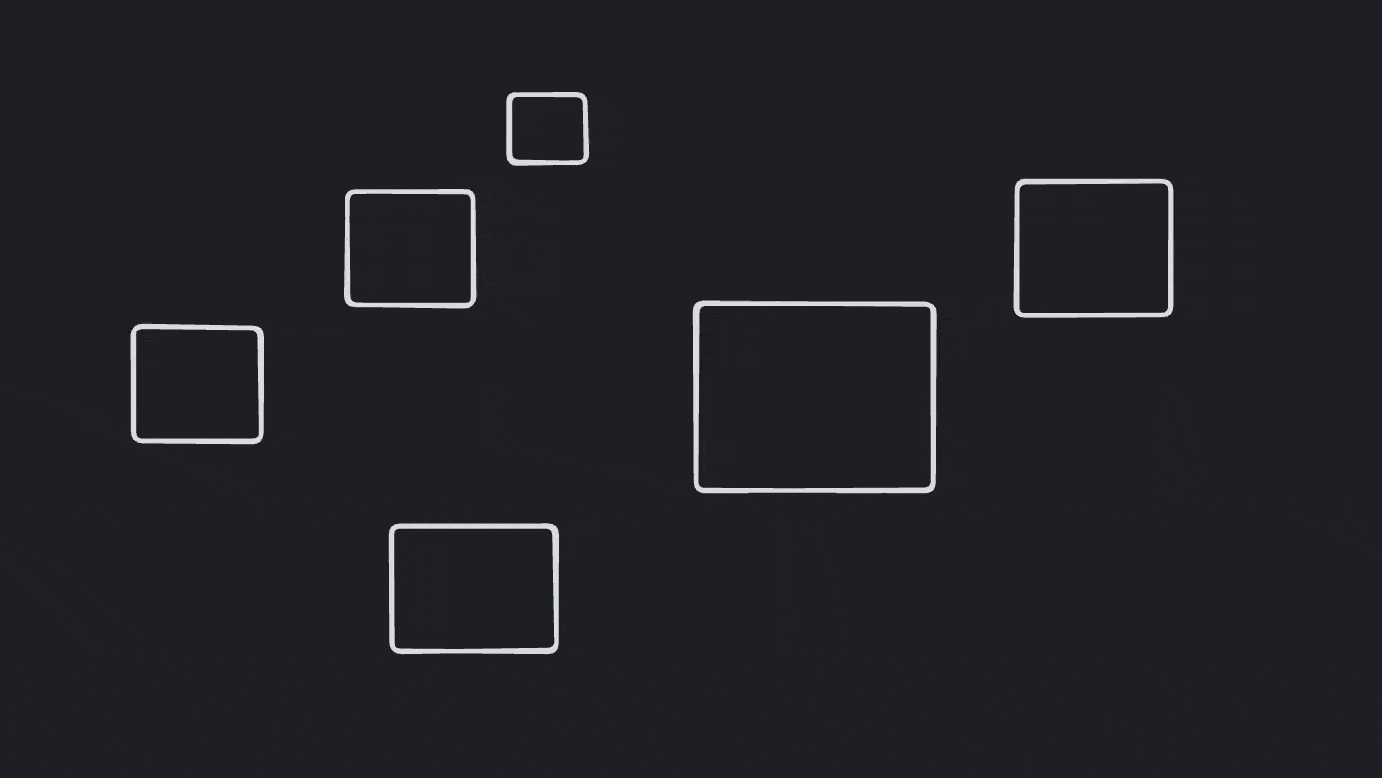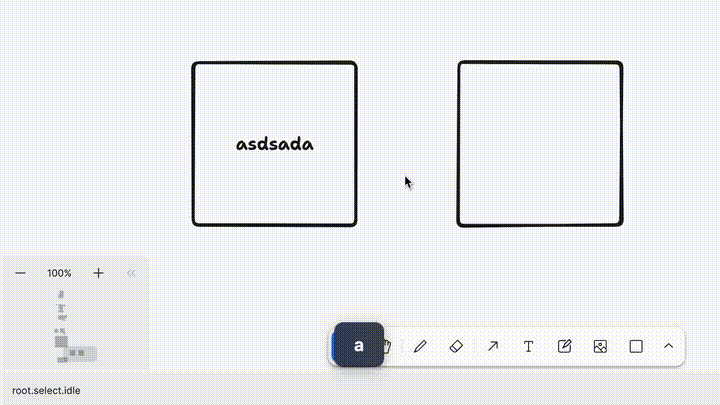This PR is a significant rewrite of our selection / hit testing logic.
It
- replaces our current geometric helpers (`getBounds`, `getOutline`,
`hitTestPoint`, and `hitTestLineSegment`) with a new geometry API
- moves our hit testing entirely to JS using geometry
- improves selection logic, especially around editing shapes, groups and
frames
- fixes many minor selection bugs (e.g. shapes behind frames)
- removes hit-testing DOM elements from ShapeFill etc.
- adds many new tests around selection
- adds new tests around selection
- makes several superficial changes to surface editor APIs
This PR is hard to evaluate. The `selection-omnibus` test suite is
intended to describe all of the selection behavior, however all existing
tests are also either here preserved and passing or (in a few cases
around editing shapes) are modified to reflect the new behavior.
## Geometry
All `ShapeUtils` implement `getGeometry`, which returns a single
geometry primitive (`Geometry2d`). For example:
```ts
class BoxyShapeUtil {
getGeometry(shape: BoxyShape) {
return new Rectangle2d({
width: shape.props.width,
height: shape.props.height,
isFilled: true,
margin: shape.props.strokeWidth
})
}
}
```
This geometric primitive is used for all bounds calculation, hit
testing, intersection with arrows, etc.
There are several geometric primitives that extend `Geometry2d`:
- `Arc2d`
- `Circle2d`
- `CubicBezier2d`
- `CubicSpline2d`
- `Edge2d`
- `Ellipse2d`
- `Group2d`
- `Polygon2d`
- `Rectangle2d`
- `Stadium2d`
For shapes that have more complicated geometric representations, such as
an arrow with a label, the `Group2d` can accept other primitives as its
children.
## Hit testing
Previously, we did all hit testing via events set on shapes and other
elements. In this PR, I've replaced those hit tests with our own
calculation for hit tests in JavaScript. This removed the need for many
DOM elements, such as hit test area borders and fills which only existed
to trigger pointer events.
## Selection
We now support selecting "hollow" shapes by clicking inside of them.
This involves a lot of new logic but it should work intuitively. See
`Editor.getShapeAtPoint` for the (thoroughly commented) implementation.

every sunset is actually the sun hiding in fear and respect of tldraw's
quality of interactions
This PR also fixes several bugs with scribble selection, in particular
around the shift key modifier.

...as well as issues with labels and editing.
There are **over 100 new tests** for selection covering groups, frames,
brushing, scribbling, hovering, and editing. I'll add a few more before
I feel comfortable merging this PR.
## Arrow binding
Using the same "hollow shape" logic as selection, arrow binding is
significantly improved.

a thousand wise men could not improve on this
## Moving focus between editing shapes
Previously, this was handled in the `editing_shapes` state. This is
moved to `useEditableText`, and should generally be considered an
advanced implementation detail on a shape-by-shape basis. This addresses
a bug that I'd never noticed before, but which can be reproduced by
selecting an shape—but not focusing its input—while editing a different
shape. Previously, the new shape became the editing shape but its input
did not focus.

In this PR, you can select a shape by clicking on its edge or body, or
select its input to transfer editing / focus.

tldraw, glorious tldraw
### Change Type
- [x] `major` — Breaking change
### Test Plan
1. Erase shapes
2. Select shapes
3. Calculate their bounding boxes
- [ ] Unit Tests // todo
- [ ] End to end tests // todo
### Release Notes
- [editor] Remove `ShapeUtil.getBounds`, `ShapeUtil.getOutline`,
`ShapeUtil.hitTestPoint`, `ShapeUtil.hitTestLineSegment`
- [editor] Add `ShapeUtil.getGeometry`
- [editor] Add `Editor.getShapeGeometry`
|
||
|---|---|---|
| .. | ||
| src | ||
| api-extractor.json | ||
| api-report.md | ||
| CHANGELOG.md | ||
| LICENSE | ||
| package.json | ||
| README.md | ||
| tsconfig.json | ||
@tldraw/tlschema
This package houses type definitions, schema migrations, and other type metadata for the tldraw editor's default persisted data.
There are three main kinds of types:
-
Record types
These are root record types added to the
Storeclass. They are defined in the./src/recordsdirectory. -
Shape types
These are subtypes of the root TLShape record type. They allow specifying a unique name and custom props for a particular kind of shape.
-
Asset types
These are subtypes of the root TLAsset record type. They allow specifying a unique name and custom props for a particular kind of asset.
Adding migrations
If you make any kind of change to any persisted data shape in this package, you must add migrations that are able to convert old versions to new versions, and vice-versa.
If you are making a change that affects the structure of a record, shape, or asset, update the migrations in the same file as the record, shape, or asset is defined.
If you are making a change that affects the structure of the store (e.g. renaming or deleting a type, consolidating two shape types into one, etc), add your changes in the migrations in schema.ts.
After making your changes, add a new version number, using a meaninful name. For example, if you add a new property
to the TLShape type called ownerId that points to a user, you might do this:
In TLShape.ts
const Versions = {
RemoveSomeProp: 1,
+ AddOwnerId: 2,
} as const
and then in the TLShape type
x: number
y: number
+ ownerId: ID<TLUser> | null
props: Props
parentId: ID<TLShape> | ID<TLPage>
and then adding a migration:
export const shapeTypeMigrations = defineMigrations({
currentVersion: Versions.Initial,
firstVersion: Versions.Initial,
migrators: {
+ [Versions.AddOwnerId]: {
+ // add ownerId property
+ up: (shape) => ({...shape, ownerId: null}),
+ // remove ownerId property
+ down: ({ownerId, ...shape}) => shape,
+ }
},
After you've added your migration, make sure to add a test for it in src/migrations.test.ts. It will complain if you do not!
License
The source code in this repository (as well as our 2.0+ distributions and releases) are currently licensed under Apache-2.0. These licenses are subject to change in our upcoming 2.0 release. If you are planning to use tldraw in a commercial product, please reach out at hello@tldraw.com.